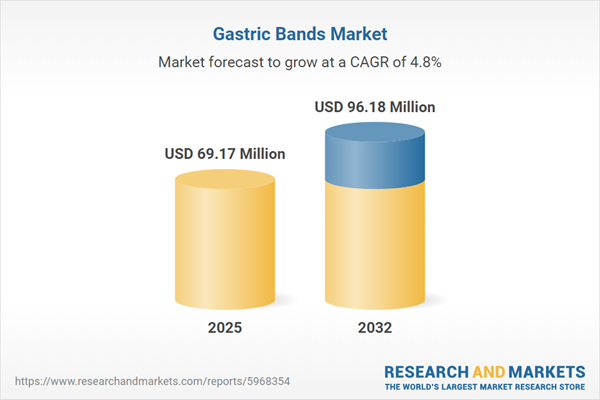Speak directly to the analyst to clarify any post sales queries you may have.
The gastric bands market is rapidly evolving in response to innovation, clinical necessity, and shifting regulatory and tariff environments. Industry stakeholders need clear insights to make informed, forward-thinking decisions in this dynamic bariatric device landscape.
Market Snapshot: Growth Trajectory and Outlook
The gastric bands market grew from USD 65.98 million in 2024 to USD 69.17 million in 2025, with projected expansion at a compound annual growth rate (CAGR) of 4.82%, reaching USD 96.18 million by 2032. This performance reflects sustained demand for minimally invasive bariatric solutions, continued device innovation, and expanding adoption across both developed and emerging regions. Growth is fueled by clinical demand to address obesity-related comorbidities alongside advancements in adjustable band technologies, digital health integration, and evolving patient management protocols.
Scope & Segmentation: Defining the Gastric Bands Market
- Product Types: Adjustable (including saline-filled systems) and non-adjustable bands, each tailored for specific treatment paradigms.
- Distribution Channels: Direct sales, distributors, online channels (including e-commerce platforms and manufacturer websites), and third-party distributors that provide strategic reach and market adaptability.
- End Users: Ambulatory surgical centers, clinics, and hospitals, with ambulatory centers offering advantages in cost and scheduling, and hospitals managing complex, multidisciplinary procedures.
- Age Groups: Adult cohorts segmented into 18-35, 36-50, and 51+; pediatric applications, under protocol, are emerging within the therapeutic mix.
- Gender: Both female and male populations, with ongoing efforts to address evolving demographic participation and awareness.
- Regional Analysis: Americas (North America and Latin America), Europe, Middle East & Africa, and Asia-Pacific; each region displays unique adoption drivers, reimbursement models, and healthcare infrastructure considerations.
- Featured Companies: Allergan plc, Ethicon Endo-Surgery, LLC, Obtech Medical AG, Cousin Biotech SAS, and Hangzhou Kangning Medical Instruments Co., Ltd., which demonstrate a range of innovation and geographic strategies.
Key Takeaways: Strategic Insights for Senior Leaders
- Rising patient preference for minimally invasive, adjustable band solutions is driving greater demand for adaptable clinical approaches and post-surgical engagement tools.
- Integration of digital health, such as telemonitoring and remote self-adjustment capabilities, is redefining postoperative care and reshaping workflow efficiencies within healthcare systems.
- Strategic alliances between medical device manufacturers, digital therapeutics firms, and healthcare providers foster comprehensive patient pathways beyond the surgical episode.
- Differentiation within distribution models—including direct, hybrid, and omnichannel strategies—supports brand integrity and increased market coverage.
- Clinical segmentation by age, gender, and patient setting enables more targeted market entry strategies and personalized device offerings, supporting both broad and niche demand.
- Competitive positioning hinges on combining device innovation with enhanced patient monitoring, behavioral support, and partnerships that allow rapid response to emerging regulatory and policy conditions.
Tariff Impact: Navigating Trade Policy Challenges
Recent U.S. tariffs on imported medical devices have added complexity for gastric band manufacturers, impacting input costs and promoting reevaluation of procurement and sourcing strategies. Some companies are shifting toward near-shoring and renegotiating supplier agreements to stabilize costs. Downstream, distributors and healthcare providers are recalibrating purchasing protocols and inventory management in an effort to maintain continuity of care and procurement efficiency. Parallel logistics and compliance requirements now require more vigilant management to prevent disruptions in device availability.
Methodology & Data Sources
This report employs a systematic, multi-source research methodology. Primary data was obtained through interviews with bariatric surgeons, procurement managers, and supply chain specialists. Secondary sources included peer-reviewed clinical journals, regulatory filings, market white papers, and financial disclosures from leading gastric band manufacturers. Quantitative findings have been validated and reconciled using triangulation techniques, ensuring results are both rigorous and actionable.
Why This Report Matters: Actionable Value for B2B Decision-Makers
- Clarifies evolving sector trends, from digital health integration to market segmentation, enabling evidence-based strategic planning and innovation roadmapping.
- Supports procurement, R&D, and policy teams in navigating trade, regulatory, and distribution challenges specific to the gastric band sector.
- Equips senior executives with actionable intelligence to assess and optimize competitive strategies within diverse and nuanced market environments.
Conclusion
The gastric bands market is defined by the intersection of technology, patient-centric care, and regulatory transformation. Leaders who combine clinical innovation with adaptive strategy are positioned to advance value creation in a competitive field.
Additional Product Information:
- Purchase of this report includes 1 year online access with quarterly updates.
- This report can be updated on request. Please contact our Customer Experience team using the Ask a Question widget on our website.
Table of Contents
3. Executive Summary
4. Market Overview
7. Cumulative Impact of Artificial Intelligence 2025
Companies Mentioned
The companies profiled in this Gastric Bands market report include:- Allergan plc
- Ethicon Endo-Surgery, LLC
- Obtech Medical AG
- Cousin Biotech SAS
- Hangzhou Kangning Medical Instruments Co., Ltd.
Table Information
| Report Attribute | Details |
|---|---|
| No. of Pages | 180 |
| Published | November 2025 |
| Forecast Period | 2025 - 2032 |
| Estimated Market Value ( USD | $ 69.17 Million |
| Forecasted Market Value ( USD | $ 96.18 Million |
| Compound Annual Growth Rate | 4.8% |
| Regions Covered | Global |
| No. of Companies Mentioned | 6 |









